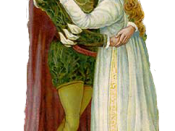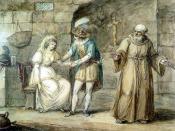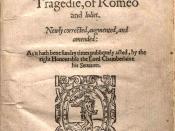Romeo and Juliet's youth produces a problem for Shakespeare: he must convince the audience of the sincerity and genuineness of their love for each other. He accomplishes this in a variety of ways. He presents courtly love and romantic love to highlight the authenticity of the romantic love and uses different techniques in his writing to strengthen this impression such as oxymorons, imagery, contrasting strong emotions and the impending tragedy.
Romeo's love for Juliet has a very different effect on him compared to his love for Rosaline. Romeo's love for Juliet seems to uplift him, whereas Romeo's love for Rosaline weighs him down and confuses him. This helps the audience believe that his love for Juliet is more genuine compared to his love for Rosaline, which could be said to be courtly love. Courtly love was a literary tradition going back to the medieval times and is still present in Shakespeare's play.
Courtly love is when young men fall in love with a beautiful young woman who they would worship but had no hope of marrying. It could be said that Romeo's love for Rosaline is courtly love. When we first meet Romeo in Act 1 Scene 1, he is sinking "under love's heavy burden" for Rosaline. Romeo pines for her as he is "out of her favour" and creates an "artificial night" for himself by shutting his windows, locking "fair daylight out". He goes out "early walking" but returns as soon as the "all-cheering sun" rises in the "farthest east". When Romeo speaks to Benvolio later in the scene he is depressed and his feelings are confused. He uses oxymorons, two opposite words placed next to one another, to show this. He speaks of "loving hate", "heavy lightness", "feather of lead", "cold fire" and "sick health". In...


